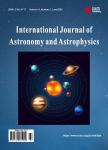A Study of Dark Matter with Spiral Galaxy Rotation Curves
A Study of Dark Matter with Spiral Galaxy Rotation Curves作者机构:Universidad San Francisco de Quito Quito Ecuador
出 版 物:《International Journal of Astronomy and Astrophysics》 (天文学与天体物理学国际期刊(英文))
年 卷 期:2019年第9卷第2期
页 面:71-96页
主 题:Dark Matter Spiral Galaxies Majorana Neutrinos
摘 要:To constrain the properties of dark matter, we study spiral galaxy rotation curves measured by the THINGS collaboration. A model that describes a mixture of two self-gravitating non-relativistic ideal gases, “baryons and “dark matter, reproduces the measured rotation curves within observational uncertainties. The model has four parameters that are obtained by minimizing a x2 between the measured and calculated rotation curves. From these four parameters, we calculate derived galaxy parameters. We find that dark matter satisfies the Boltzmann distribution. The onset of Fermi-Dirac or Bose-Einstein degeneracy obtains disagreement with observations and we determine, with 99% confidence, that the mass of dark matter particles is mh 16 eV if fermions, or mh 45 eV if bosons. We measure the root-mean-square velocity of dark matter particles in the spiral galaxies. This observable is of cosmological origin and allows us to obtain the root-mean-square velocity of dark matter particles in the early universe when perturbations were still linear. Extrapolating to the past we obtain the expansion parameter at which dark matter particles become non-relativistic: ahNR=[4.17±0.34(STAT)±2.50(SYST)]×10−6. Knowing we then obtain the dark matter particle mass mh=69.0±4.2(stat)±31.0(syst)eV, and the ratio of dark matter-to-photon temperature Th/T=0.389±0.008(stat)±0.058(syst) after e+e−annihilation while dark matter remains ultra-relativistic. We repeat these measurements with ten galaxies with masses that span three orders of magnitude, and angular momenta that span five orders of magnitude, and obtain fairly consistent results. We conclude that dark matter was once in thermal equilibrium with the (pre?) Standard Model particles (hence the observed Boltzmann distribution) and then decoupled from the Standard Model and from self-annihilation at temperatures above mμ. These results disfavor models with freeze-out or freeze-in.



